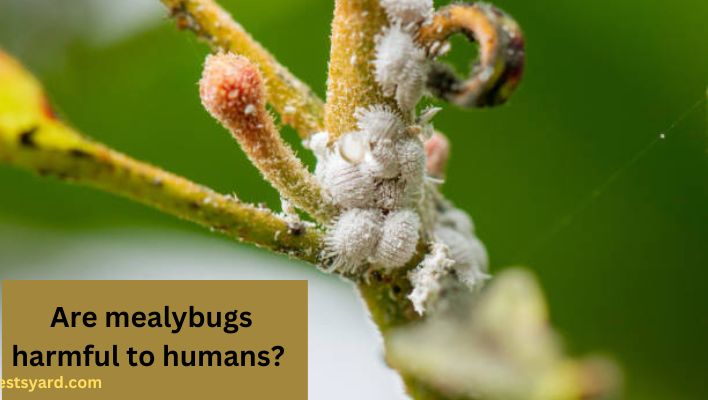Mealybugs are tiny, soft-bodied insects that look like fuzzy white lumps. They live on vascular plants, attacking leaves and stems by piercing them with their glossy mouthparts. Mealybugs can be found in several environments, including indoor homes and gardens. In this article, I will answer whether mealybugs are harmful to humans or not.
Mealybugs are a type of insect that are harmless to humans. But do mealybugs bite? Can they climb walls? What do mealybugs look like? And what to do if you see them in your home? I’ll explain all these things and more in this article, so read on.
Mealybugs are a type of soft insect that looks like a tiny grain or seed. They get their name from the fact that they produce a white or yellow “waxy substance.” And feed on plant sap, which causes stunted growth of plants and reduced yields because the leaves get covered with mealybugs.
They leave behind a powdery residue (hence “mealy”) that gives them their characteristic white appearance. These bugs are small and typically found on leaves or stems.
They’re often seen as a nuisance since they can damage, cause stunt growth and reduce yield. Fortunately, there are ways you can protect yourself from these little critters that have no right to live on plants.
What are mealybugs
Mealybugs are tiny, white insects found on plants and in soil. They’re often mistaken for aphids, but mealybugs have different colors and shapes. They don’t have wings, and their bodies are covered in waxy hairs that give them a fuzzy look. Mealybugs are great at eating plant sap, which is why they’re often found around the base of plant stems.
They are tiny insects that feed on the leaves of plants. They are often found in greenhouses and can be a problem for people who grow vegetables in their home gardens. In some cases, they may also be found on other plants, like roses or fruit trees. Mealybugs don’t do much harm to plants themselves, but they can become annoying when they are allowed to multiply and infest a plant.
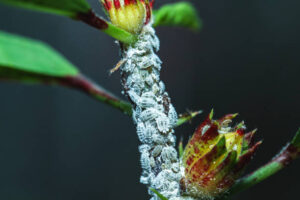
Mealybugs look a lot like aphids but are a different species altogether. The sap is also what the mealybugs feed off of, so if you see them around your trees, you may want to consider treating them with insecticide.
Mealybug eggs are about 1/50th of a millimeter across and hatch into tiny white or gray larvae. The larvae are about 1/300th of an inch long with legs that look like small hooks. Mealybug nymphs (the stage between larvae and adults) have fuzzy bodies and four pairs of wings that look like a mosquito’s wings; each wing has two different colors: one set is lighter than the other. The nymphs eat at night, leaving behind many empty shells around their food source; this process is called “caterpillar feeding.”
What causes mealybugs?
Mealybugs are the most common type of insect infestation in plants. They are typically small, white, and fuzzy and can be found on many different types of plants. While they are not harmful to humans or animals, they can damage plants, causing malformation and even death.
Mealybugs develop when an insect or disease has damaged a plant or if the plant is exposed to certain conditions. These insects are usually found on plants that have been contaminated with microscopic particles from a fungus, bacteria, or viruses. There are two types of mealybugs: those that feed on leaves and those that feed on roots.
The two most common causes of mealybugs are:
- Interaction with other pests, such as aphids and whiteflies.
- A lack of water or fertilizer
- High temperatures (above 80 degrees F)
- Low humidity levels in the environment
- Lack of air circulation
- Interaction with pathogens such as viruses or bacteria.
Mealybugs are not harmful to humans.
Mealybugs feed on the sap of plants, usually in the form of sap-sucking insects like aphids and scales. They are also known to feed on other plants, including flowers, leaves, fruit, and even nuts. So, mealybugs are not harmful to humans.
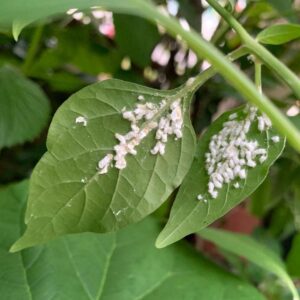
The adult mealybugs don’t harm humans; they just consume their food source and reproduce. But the immature ones look like white powdery spots on plants, and they can be extremely irritating to the eyes if you rub them against your face.
They do not bite or sting, but they can cause a lot of damage to your plants if you don’t treat them correctly. The most common type of mealybug is the white mealybug, also called the cottony cushion scale.
The white mealybug can be found on a wide range of plants, including vegetables like zucchini, cucumbers, apples, and citrus fruits like oranges.
Mealybugs harmless to pets
Mealybugs are tiny parasitic insects that feed on plant sap. They are usually found on plants in your home, but they can also be found on fruits and vegetables in stores or other people’s homes.
Mealybugs are not harmful to pets; they don’t bite, sting, or carry diseases. However, seeing them on your pet’s fur or skin could be a sign of an allergy or irritation in the animal.
The mealybug itself isn’t harmful, but if your pet has an allergy to it and eats it, they’ll get sick. The symptoms are similar to what you might get if you have a cold: sneezing, coughing, runny nose, and eyes. You’ll also want to make sure your pet doesn’t eat any of the leaves that were contaminated by the mealybugs.
While mealybugs are not harmful to dogs or cats, they can cause serious health issues for birds and other wildlife. Birds eating mealybugs may develop anemia or even die from gout-like symptoms caused by high uric acid levels in their blood.
If you’ve discovered mealybugs on your lawn or planter box, it’s important to remove them immediately so that these animals won’t be harmed by eating them (and so that you don’t get sick).
Can mealybugs infest a house?
Mealybugs can be transported indoors on clothes and other belongings that have contact with them outdoors. Because they are attracted to light and movement, they tend to congregate near windows during the daytime hours of dawn and dusk when temperatures are cooler below 50 degrees Fahrenheit (10 degrees Celsius).
For mealybug infestation to occur indoors, there must be an abundance of these pests in the environment around your area.
Mealybugs prefer humid conditions and often congregate near windows or in areas with high humidity. They also like warm temperatures and can be found in kitchens, pantries, basements, and closets.
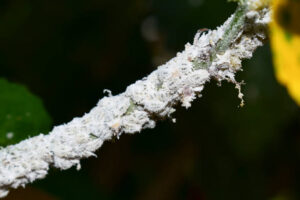
The most common locations where mealybugs may occur are around windows, on walls, or inside the insulation around ductwork. If you see these insects flying around your home and think they might be mealybugs, removing them immediately before they infest your home further is important.
So how do you know if you have mealybugs? It’s pretty easy: they look like tiny white cotton balls stuck on your plants. You’ll see lots of them clustered together in groups, but not all over your house or in every room; you’ll only find them where the plants are located (usually near light sources).
Best insecticide for mealybugs
Bonide Captain Jack’s Insecticidal Super Soap
Bonide Captain Jack’s insecticidal super soap ready-to-Use minimizes and eliminates various pest infestations over time. These formulas work incredibly fast with no harmful residue. Plus, it’s made with the highest quality ingredients backed by a 100% satisfaction guarantee.

This Soap is formulated to kill crawling insects, including ants, roaches, and spiders, without leaving behind a bad smell or residue. The soap kills mealybugs, chiggers, and other crawling insects by displacing or dissolving their waxy outer covering allowing the insecticide to penetrate the insect’s shell. With excellent residual activity against over 20 pests, this insecticide will keep your plants safe and free from pests.
BioAdvanced Rose & Flower Insect Killer RTU
BioAdvanced Rose & Flower Insect Killer RTU is the perfect solution for the mealybug infestation that plagues your home.
This is a ready-to-use, non-toxic product that kills mealybugs on contact and prevents them from returning to your home. It contains a unique combination of active ingredients that deter, kill, and repel mealybugs on contact with surfaces where they hide.

The product is made with a non-hazardous formula that will not harm pets or people and is safe for kids and pets. The odorless formula will not stain surfaces, and its low profile makes it easy to apply without getting tracked into other areas of the house.
This insecticide is effective against many insects, including ants, cockroaches, crickets, earwigs, fleas, flies, gnats, silverfish, and ticks.
Ortho MAX Malathion Insect Spray Concentrate
The best way to get rid of mealybugs is with Ortho MAX Malathion Insect Spray Concentrate. This insecticide will kill mealybugs in a single application, so you don’t have to worry about reapplying it repeatedly until your mealybugs are completely gone.
The spray also has a pleasant smell that makes the room feel clean and fresh after you use it. It’s specially designed to be safe for pets and kids and effective against ants, roaches, spiders, termites, fleas, hedgehogs, and more.
This insecticide works by killing mealybugs by disrupting their nervous system. It is a contact insecticide that can be applied directly to plant foliage and soil around the base of infested plants.
How to prevent mealybugs
Mealybugs are a nuisance, but they’re easy to get rid of. Here’s how to prevent them from coming back to your house or garden:
- Clean the plants with a good disinfectant.
- Make sure your soil has enough water and fertilizer.
- Do not over-fertilize your plants, which can encourage mealybugs to infest.
- Keep the humidity low.
- Remove any weeds or debris from around your plants
- Use natural predators
- Don’t over-fertilize
- Don’t let the soil dry out
- Use a good quality, organic pesticide.
- Keep your plants healthy.
How to get rid of mealybugs
Mealybugs are a common problem in home gardens but can be easily treated. If you’re having trouble getting rid of mealybugs, try the following methods:
Use chemicals.
The first thing you should do is use chemicals. It’s not a good idea to try and get rid of mealybugs by scrubbing them with vinegar or other household cleaners, but if you are desperate enough, some pesticides can kill them.
The best way to get rid of mealybugs is by using pesticides. There are many different types of pesticides that will kill mealybugs; some of them are Bonide Captain Jack’s Insecticidal, BioAdvanced insecticide, Ortho MAX Malathion Insect Spray, or Bacillus thuringiensis (Bt). BT kills the eggs and larvae of the mealybug in your home and makes it so that they don’t reproduce.
You can buy Bt from your local gardening store or online at [company name]. If you’re worried about using chemicals in your home, there are other options. You can also use an insecticidal soap spray or a fogger filled with water and Bt spray inside your home.
Use insecticidal soaps
You can get rid of mealybugs by using insecticidal soap. These soaps are made with ingredients that kill insects and their larvae.
You can use these soaps directly on the mealybugs or spray the mealybugs and their environment with the soap. You’ll need to repeat this process every week until you no longer see pests in your house or yard.
Mix two teaspoons of insecticide soap in a spray bottle and spray your plant with this solution. You should also ensure that you’re using a soap that is safe for your plants and doesn’t contain pesticides or other chemicals that could harm them.
Once you’ve applied the soap, let it sit on the leaf surface for 1-2 days before applying another coat of soap or using a sprayer to hose down your plants again. Repeat this every day until no more mealybugs are on your plants or leaves.
Spray with horticultural oil
One of the best ways to get rid of mealybugs is by spraying your plant with horticultural oil. The oil will suffocate the mealybugs, and they’ll die off, so that’s a great way to avoid using pesticides on your plants.
This method also works because it doesn’t kill other beneficial insects like ladybugs or bees that eat mealybugs. Also, this will kill off any insects or eggs present and prevent new infestations from developing in the future.
Wash with alcohol.
A clean cloth dipped in alcohol will get rid of mealybugs. You can also use a spray bottle filled with rubbing alcohol.
You can also wash your plants thoroughly with a solution of 1 part rubbing alcohol and three parts water. This will kill the mealybugs on contact, so don’t worry about getting any in the sink or your hands.
Then, let the plant dry out before you put it back into its pot or container. You can also spray the leaves with rubbing alcohol after washing them; just make sure not to get it on anything else.
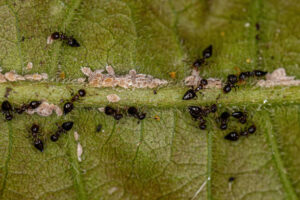
Attract predators
Another good way to get rid of mealybugs is to attract predators that eat them. Lacewings, ants, and ladybugs are some of the most common predators of mealybugs, but there are also species suited for more specific tasks.
For example, the aphid midge will only attack aphids, and the spider mite will only attack spider mites. These predators are great because they’re specific enough to target what you want them to.
Use neem oil
Neem oil is a natural insecticide that’s nontoxic to humans and animals and effective against various pests, including mealybugs. It’s safe to use around pets and children, but it’s not recommended for use in the garden.
Neem oil can be used in several ways:
- Mix 1 part neem oil with two parts water and apply to the area where you see the mealybugs.
- Spray or pour some neem oil into an empty spray bottle and shake it up thoroughly before applying it to your plants’ leaves.
- Apply neem oil to your plants’ leaves by dipping them in the solution or spraying it directly onto the leaves.
Use a white vinegar spray.
If you don’t want to use any harmful chemicals on plants or animals, choose a non-toxic spray made with white vinegar instead. White vinegar contains acetic acid, which will kill mealybugs on contact.
Spray the vinegar solution onto the leaves of your plants and wait for them to dry completely before watering them again. You can also spray the vinegar directly onto the mealybugs themselves if they’re on your houseplants or yard decorations.
Prune away the mealybugs
If you’re dealing with an infestation of mealybugs, there may be too many of them to just get rid of them all at once; you may need to go through your plants one by one and cut away the infested areas until the problem is under control.
To prune away the mealybugs, you’ll need a sharp pair of shears or clippers and a clean box to work in. Using these tools, carefully cut off any dead branches or leaves infested with mealybugs; don’t use any other method that could damage your plant’s health.
Once you’ve done this, dispose of any remaining materials safely outside, don’t just throw them away. You should also check your plants regularly for signs of new infestation until they’re fully cleared up.
